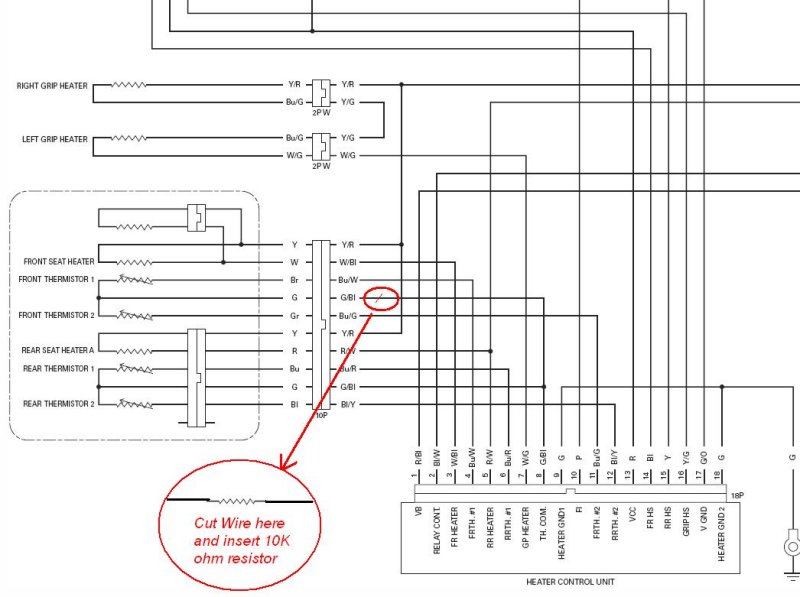First off, let me say that if you are satisfied with the way your heated seats work, LEAVE THEM ALONE and please SKIP THIS THREAD.
WARNING: DO NOT ATTEMPT IF YOU ARE ELECTRICALLY CHALLANGED. CUTTING INTO YOUR BIKES WIRE HARNESS CAN RESULT IN BAD THINGS IF YOU AREN'T 100% CERTAIN OF WHAT YOU ARE DOING.
IF YOU DO THIS MODIFICATION IT IS AT YOUR OWN RISK
However, if you are one of those that feels your seats don't get hot enough, I may have a way to help you, but it will require you make a modification to the wire harness.
Before I get into the actual mod, let me tell you the results of my measurements. I took a cold seat at about 55 degrees and measured the thermistor values in it. They are all around 67K to 69K ohms. I then put it back on the bike and ran the seat heater on high and remeasured them. They were around 35K ohms after few minutes. Unfortunatly, it doesn't get that cold here in Texas, so I was unable to measure the thermistors at any temp lower than about 55 degrees, but I suspect the thermistors would probably rise another 20K ohms or more when really cold soaked around freezing.
If you look close at the circuit for the front seat, you will see it has two thermistors connected to a common ground. So to raise the seat temperature, all you have to do is add resistance, and the best place to do this is on the common ground line.
I began with 10K ohms, then tried 20K ohms and 30K ohms. 30K ohms was WAY TOO MUCH, and got the seats too hot. I measured seat temps both with an infarred temp gun, and by the seat of my pants, so to speak. What I thought felt about right in the garage was 20K ohms, so I put that in and went for a ride. I found that with a 20K ohm resistor in, even on the lowest setting, I couldn't get the seat temp low enough for it to be comfortable in 55 degree weather. So it seems like the trick is finding the very lowest value of resistor you can that will still let you use the low setting when you want, but slightly increasing the heat out of the seat on all settings. I went back and put in the 10K resistor and went for a ride. For me, this is perfect. It has about the same effect as turning up the dial one notch at all settings, and I couldn't stand having it all the way on high at the current ambient temp of about 55 degrees.
Also, be aware, there are TWO green/black ground wires in the harness for the grounds to the thermistors. One is for the rear passengar elements and one is for the riders. You have to make sure you cut the right one. On the 2009, it is in the center position of the connector. If you are unsure, leave it alone.
Also, be aware that some of the color codes have on the seat heater wires have change since 2006, but the grounds are still green with a black stripe.
And please, whatever you do, don't use a resistor larger than 20K ohms. You'll be sorry if you do.
Also, be warned that I have not tested this mod in colder temps. It is very possible that the seats could end up getting TOO HOT when the temp drops further. This is another reason why I suggest you use the smallest value resistance possible.
Schematic
![Image]()
This is the common ground for the riders thermistor circuit
![Image]()
OH MY GOD!!!
![Image]()
Resistor installed (I later changed this 20K to a 10K)
![Image]()
All covered up with heat shrink
![Image]()
WARNING: DO NOT ATTEMPT IF YOU ARE ELECTRICALLY CHALLANGED. CUTTING INTO YOUR BIKES WIRE HARNESS CAN RESULT IN BAD THINGS IF YOU AREN'T 100% CERTAIN OF WHAT YOU ARE DOING.
IF YOU DO THIS MODIFICATION IT IS AT YOUR OWN RISK
However, if you are one of those that feels your seats don't get hot enough, I may have a way to help you, but it will require you make a modification to the wire harness.
Before I get into the actual mod, let me tell you the results of my measurements. I took a cold seat at about 55 degrees and measured the thermistor values in it. They are all around 67K to 69K ohms. I then put it back on the bike and ran the seat heater on high and remeasured them. They were around 35K ohms after few minutes. Unfortunatly, it doesn't get that cold here in Texas, so I was unable to measure the thermistors at any temp lower than about 55 degrees, but I suspect the thermistors would probably rise another 20K ohms or more when really cold soaked around freezing.
If you look close at the circuit for the front seat, you will see it has two thermistors connected to a common ground. So to raise the seat temperature, all you have to do is add resistance, and the best place to do this is on the common ground line.
I began with 10K ohms, then tried 20K ohms and 30K ohms. 30K ohms was WAY TOO MUCH, and got the seats too hot. I measured seat temps both with an infarred temp gun, and by the seat of my pants, so to speak. What I thought felt about right in the garage was 20K ohms, so I put that in and went for a ride. I found that with a 20K ohm resistor in, even on the lowest setting, I couldn't get the seat temp low enough for it to be comfortable in 55 degree weather. So it seems like the trick is finding the very lowest value of resistor you can that will still let you use the low setting when you want, but slightly increasing the heat out of the seat on all settings. I went back and put in the 10K resistor and went for a ride. For me, this is perfect. It has about the same effect as turning up the dial one notch at all settings, and I couldn't stand having it all the way on high at the current ambient temp of about 55 degrees.
Also, be aware, there are TWO green/black ground wires in the harness for the grounds to the thermistors. One is for the rear passengar elements and one is for the riders. You have to make sure you cut the right one. On the 2009, it is in the center position of the connector. If you are unsure, leave it alone.
Also, be aware that some of the color codes have on the seat heater wires have change since 2006, but the grounds are still green with a black stripe.
And please, whatever you do, don't use a resistor larger than 20K ohms. You'll be sorry if you do.
Also, be warned that I have not tested this mod in colder temps. It is very possible that the seats could end up getting TOO HOT when the temp drops further. This is another reason why I suggest you use the smallest value resistance possible.
Schematic

This is the common ground for the riders thermistor circuit

OH MY GOD!!!

Resistor installed (I later changed this 20K to a 10K)

All covered up with heat shrink









